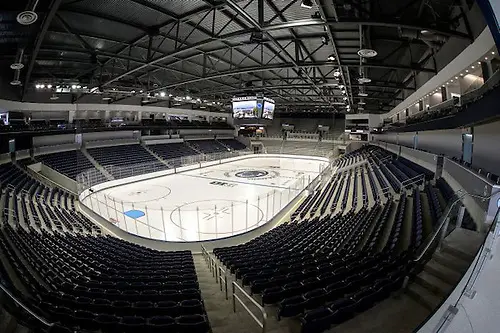Candace: Well Arlan, we’re only a couple of weeks into the season, and already we are seeing some interesting results. I’m not sure what has been the most surprising, because there have been several, so let’s just start with something that hasn’t been a surprise. Minnesota has been pushed a bit, particularly by Wisconsin on Friday, but continues to find a way to win. We knew they wouldn’t be quite as dominant as last year, but what is your early impression of Minnesota?
Arlan: The Gophers seem to be making strides, but as you said, they’ve got a long way to go. In each of the first two weekends, they were markedly better on Saturday than on Friday. Opening at Colgate, it looked like Minnesota had totally forgotten how to complete a pass. They made progress on that front in the second game, but the Badgers historically make connecting on passes difficult. Wisconsin was able to shut down Minnesota’s top line of Hannah Brandt, Maryanne Menefee, and Rachael Bona that carried the Gophers over Colgate, although Brandt and Menefee did combine on a power-play goal that immediately erased the Badgers’ only lead of the weekend. The offense only scored twice per game versus UW, but the Badgers limited last season’s juggernaut to two goals in half of the four meetings as well. The Gophers’ new dimension up front is Kelly Terry with rookie wings Dani Cameranesi and Kate Schipper; that promises to be one of the fastest lines in the country and will make life miserable for opponents with their forecheck pressure.
The coaches expected Amanda Leveille to be strong in net. After seeing minimal minutes as a rookie, she looks to have played the rust off of her game. If her typical performance is close to what she showed against Wisconsin, then Minnesota’s goaltending question has been answered positively. The X-factor for the Gophers figures to be the blue line, where they have to find three replacements. They played junior Jordyn Burns and three freshmen along with the three returning defensemen, and to date, nobody has played themselves out of consideration. They should develop a workable corps, maybe even a very good group of defensemen once people adjust to the college game and each other. I don’t see it approaching the fortress that Minnesota could deploy last year.
Despite the losses, Wisconsin must be encouraged by what the Badgers have shown. Even without Annie Pankowski, centralized with the United States national team, the freshmen look stronger than the past couple of classes. Forwards Sarah Nurse and Sydney McKibbon and defenseman Mellissa Channell were all conspicuous in a good way in Minneapolis.
The Badgers will be a top-five defensive team, as they seemingly always are. They made Minnesota look positively awful in the second period Friday, although the Minnesota skaters would have to share in the responsibility for that appearance. The key will be whether or not they can find the net often enough against top competition without Brianna Decker around to help guide the way. The single goal on the weekend only matches what they did versus Minnesota last year.
Do you see Wisconsin differently?
Candace: I think we are in agreement. We knew Wisconsin would be a tough team to score against, because the Badgers have arguably the best goalie in the women’s college game right now in Alex Rigsby. The return of Brittany Ammerman to the lineup after she was out most of last year helps a bit on the offense, but this team doesn’t have the star offensive players it did in years past with players like Meghan Duggan, Brooke Ammerman, and Decker all on the team at the same time. I expect the Badgers to be in the hunt, simply because they will be so hard to score against. If Minnesota has a lapse, expect the Badgers to be the team that is right there ready to capitalize. At this point, I might give the Badgers an edge over the rest of the conference for second.
The other teams of course, that expect to challenge every year, are North Dakota and Minnesota-Duluth. North Dakota had two huge losses to graduation, as the Lamoureux sisters have moved on. So far however, offense hasn’t seemed to be a problem, as Meghan Dufault, Josefine Jakobsen, Michelle Karvinen, and freshmen Susanna Tapani and Gracen Hirschy have shown scoring prowess. However, defense and goaltending may still be an Achilles’ heel. On Saturday against Minnesota-Duluth, North Dakota had to rally from a 3-1 third period deficit, and on Sunday, they gave up three goals to the Bulldogs in quick succession in the second and had to rally again in the third to earn a tie.
Of course, that may also say something about a Bulldogs squad that we may have overlooked a little coming into this year. Freshman defenseman Lara Stalder leads the Bulldogs in scoring with nine points, and is looking like a star so far in this short season. Jenna McParland is also playing well, and Kayla Black is solid in net. It wouldn’t surprise me to see Duluth back in the hunt for the WCHA crown either.
Or am I reading too much into it? What is your take on Duluth and North Dakota?
Arlan: Like many coaches around the country this season, Shannon Miller and Brian Idalski have young, talented teams that figure to be works in progress for much of the season. Both have sophomore goaltenders that can look very solid at times and a bit shaky at others, so the play of those in front of them will be vital. On the goal that started UND’s rally on Saturday, the Bulldogs had players back in front of Black, but they didn’t do a good job of coverage or tying up sticks. When Jakobsen scored the final goal to knot the score on Sunday, UMD was outnumbered down low, three skaters to one. Such situations can produce a lot of red goal lights, so I expect Miller to clean up a lot of that this week in preparation for a visit from Minnesota.
North Dakota figures to be right in the mix with squads like Boston College and Clarkson for top scoring offense in the country. Defense will likely determine their fate, and Hirschy and Halli Krzyzaniak will be asked to carry a heavier load than the average freshman defenseman.
The other obstacle both teams will have to overcome is the impact of the Olympics and preparation for it on their rosters. UMD is already minus Brigette Lacquette, on the brink of her junior season. If she is cut by Team Canada, will she return for half a season as Jocelyne Larocque did, or sit out the second semester as most others have opted to do? I’d expect that Tea Villila is still in the running for a spot with Finland, and I doubt that the Swiss have six defensemen better than Stalder. That could leave the Bulldogs a little short on the back end for a few weeks. North Dakota figures to lose some scoring punch and depth at various points of the season, so a key factor for both teams will be what games players miss and how that affects the conference standings and perhaps the PairWise Rankings.
While either of those teams could finish ahead of Wisconsin and Minnesota, they could conceivably be behind Ohio State. The Buckeyes have already experienced both good, in the form of a road win at Mercyhurst, and bad, represented by a home tie with St. Cloud State and a puzzling exhibition loss to a junior team. OSU is trying to replace a senior class that outside of Hokey Langan didn’t put up eye-popping numbers, but Paige Semenza, Tina Hollowell, and Minttu Tuominen were key contributors on both ends of the ice.
Or do you see the Buckeyes having all they can do to stay ahead of a team like Minnesota State that has an upset of Mercyhurst of its own?
Candace: I’m not sold yet on Ohio State. They clearly have talent, but I think they are young and maddeningly inconsistent. Exhibit A would be the game Friday against St. Cloud. For Ohio State to challenge in the WCHA, that’s a game they have to win. You can’t afford to drop those games and still be able to keep up with Minnesota, Wisconsin, North Dakota, and Minnesota-Duluth.
Another issue I see with Ohio State is scoring. Their top two scorers so far are defensemen, Kari Schmitt and Sara Schmitt. Ally Tarr is putting up the points, but after that, few of the forwards have stepped up. I think that makes them vulnerable. On the plus side, Chelsea Knapp sports a very respectable .926 save percentage, so she might be able to keep the Buckeyes in games when they don’t score.
Moving east, we have two teams that we expected to be contending, Clarkson and Boston College, both doing well early. I caught some of Saturday’s webcast of the Boston College game against St. Lawrence, and the Eagles, as always, showed a lot of speed. Goalie Corinne Boyles made the stops she needed to. With Boston University looking vulnerable in its opening weekend and Northeastern still struggling with Kendall Coyne off at the Olympics, is this the year BC claims Hockey East?
Also, what is your take on BU and Northeastern so far? The Huskies have struggled to score, and the Terriers tied RPI and almost lost to Union, with only some late-game heroics giving them the win.
Arlan: Unless the situation changes drastically, I don’t see who is going to be able to challenge BC in Hockey East. The Eagles have to be the biggest favorite to win a regular-season title from all of the four conferences. I thought Boyles took a big step forward last season in terms of consistency. With that, I’d expect fewer of those games where BC doubles up on somebody on the shot chart yet manages to lose. Frankly, I don’t expect the Eagles to do much losing at all. They have too much talent and speed up front that the other HEA squads can’t match. Haley Skarupa, the subject of this week’s column, has jumped out of the blocks, rookies like Andie Anastos and Haley McLean are showing up on the score sheet, and I’d expect Emily Field and Dana Trivigno to get it going sooner rather than later. If no other team rises in the conference, then BC’s problem may be more akin to the obstacle that faced New Hampshire back when the Wildcats were dominating the league: Where do the games come from that force a team to get better? The Eagles have Quinnipiac, Cornell twice, and Harvard in the first half, but other than a possible second date with the Crimson in round two of the Beanpot, BC will need competition from Hockey East.
BU looks nothing like the team that played in the final in terms of offensive capability. Just glance at career points for forwards gone from that line chart: Marie-Philip Poulin, 127; Jenelle Kohanchuk, 138; Isabel Menard, 173; Jill Cardella, 88. The tops on the current roster are junior Kayla Tutino and senior Louise Warren in the 60s, with sophomore Sarah Lefort next with 43. I’m sure the team has talent and newcomers like Samantha Sutherland and Maddie Elia will chip in, but it isn’t proven talent to the degree that Brian Durocher has had of late. Those questions are compounded by the loss of Shannon Doyle to injury from the blue line; the Terriers still have Kaleigh Fratkin and Shannon Stoneburgh back there, but I don’t know that they can replace Doyle’s skill set.
Northeastern is intriguing in that I’d assume players will be getting more opportunity than in the past and a star could emerge, but it just seems like there will be bumps along the way while trying to find new scoring punch. Union and RPI both seem to have elevated their play, but I’d have wanted to see more from a team that is going to challenge for the league title.
Other options are teams like Providence and UNH that have been posting up-and-down results, and a possible dark horse in Vermont that has yet to start running like a champion. Is there a threat to the Eagles that I’m neglecting?
Candace: Providence is the only other team I see possibly emerging to challenge Boston College. I was impressed that the Friars clamped down defensively and edged Mercyhurst in the second game of a two-game set in Providence this weekend, especially after getting blown out in the first game. However, I think Providence, as demonstrated so far this year, is vulnerable to inconsistency. The Friars are young, with only four seniors among the forwards and blue line. They have excellent goaltending in sophomore Sarah Bryant, and senior Corinne Buie is a scoring threat, but after that, it falls off. So far, the Friars have split their two series, including a disappointing 5-2 loss to Union in their first game of the year, so until Providence can tighten the ship, I’ll say Hockey East is Boston College’s to lose.
Of course, I’ve seen pressure do funny things to teams. I think the key for the Eagles will be to stay relaxed, and in that respect, I think Saturday against St. Lawrence really showed something. The teams were tied, 1-1, entering the third, and St. Lawrence had outshot BC to that point, yet the Eagles rallied and for the most had the best of the play in the third, even if they were outshot 13-12.
Speaking of Mercyhurst, they are another team that looks a little inconsistent and vulnerable. Of course, so does the rest of the CHA. Syracuse has been a surprise, beating Northeastern and really challenging Clarkson. You pointed out in your season preview that the Orange have a dismal record against the Lakers; is this the year it changes?
Arlan: One would think that Syracuse would be able to beat Mercyhurst this year; everyone else has. However, an 0-23-1 all-time record versus a team can start to get into a lot of heads, both on the winning and losing side. It was less surprising when the Lakers featured Agosta and company and Syracuse was a new program. Now, the odds would have to favor the Orange taking at least one game in four or five chances. So, yes, I’d say that streak comes to an end, but we’ve all seen the degree of accuracy that comes with my predictions of streaks ending.
You mentioned the Syracuse games versus the Golden Knights. It would be interesting to know how much the Orange really pushed Clarkson. They only scored once in two games, and even in the 2-1 game on home ice, they were outshot 41-18. It could be a case of Clarkson controlling the game and Kallie Billadeau keeping the score close. That was the only game Syracuse has played at home to date. It gets BC and Union — kind of an odd pairing there — at home in two weeks. Otherwise, it is on the road until Robert Morris comes calling on Nov. 22. If the Orange can remain competitive through this road-heavy stretch, the schedule could set up for a run later. First up, they travel to Providence, and that should provide a good basis to compare their performance versus the Friars with that turned in by the Lakers, but given the wild swings in PC results, we may not learn all that much.
The CHA contains more than its share of unpredictable teams. We’ve certainly not come close to figuring out Robert Morris. RIT’s scores cover a wide gamut, and over its first season plus of playing full-time D-I opponents, Penn State is 2-1-1 at Vermont and 1-26-1 everywhere else. Hopefully, Pegula Ice Arena will help that second statistic. The Nittany Lions start an eight-game home stand in their new digs on Friday versus Union. The constant in the league so far has been that Nicole Hensley will face a lot of rubber, and without top scoring threat Alison Wickenheiser in the lineup, Lindenwood won’t win.
How do you think the CHA will evolve? A two-team race? Three teams, four teams? No race at all?
Candace: Just based on history, I’d say it’s a Mercyhurst conference and everyone else until proven otherwise. However, the Lakers have looked a lot more vulnerable so far this season than they have in years past. Eventually, a CHA team other than Robert Morris has to start beating the Lakers. For that matter, why not RIT, which has prior championship experience as a D-III team? Of the six teams in the CHA, I’d give the Lakers the most talent. Christine Bestland continues to one of the best offensive players in the game. Jenna Dingeldein continues to play well as a sophomore, and Molly Byrne anchors the back line well. However, the Lakers have an unproven goalie in Amanda Makela, and so far, she has played every game. I don’t know if Mike Sisti is reluctant to try out Sara Besseling or Julia DiTondo, but I don’t think Makela’s stats mean that she should be playing the net every time.
If the goaltending is suspect, then I see no reason why more teams couldn’t challenge in the CHA. It would actually be good for the conference. Mercyhurst has won the league regular season title every year (they shared it with Wayne State in 2007-2008), and has won the CHA tournament every year except 2012, when Robert Morris stunned the Lakers. Syracuse could be that team, and so could Robert Morris, if the Colonials weekend sweep of Bemidji State means they have gotten over some inconsistent play.
Let’s move over to the ECAC. So far, Clarkson has looked very strong. Erin Ambrose shows no sign of a sophomore slump, as she leads the Golden Knights in scoring. Carly Mercer and Jamie Lee Rattray are also playing well, and Erica Howe is her usual rock solid self. You picked Clarkson to win the conference this year, and so far, they certainly look to be justifying that pick.
Arlan: Coming into the season, I felt that Clarkson had the fewest unknowns and positions that had to progress in a certain way in order for it to be successful. Based on what the Golden Knights returned compared to other contenders, they were the most complete team right out of the chute. Now, it becomes a matter of how much they can improve over the course of the season, and the next couple of weeks should be revealing when they host a series against Mercyhurst and then play a road game at Cornell. The Lakers’ struggles may have taken a bit of the luster from that matchup, but between the games at Potsdam, N.Y., and later home series with Maine, St. Lawrence, and Cornell, there’s still time for Mercyhurst to better that nonconference record. However, if Clarkson won both this weekend and Mercyhurst fell to 2-5-0, that becomes a bigger hill to climb. Clarkson would love a sweep, but the Lakers cannot afford to get swept.
As for Clarkson’s competition in the ECAC, we’re still waiting on Cornell and Harvard. The Big Red will have a different look without Brianne Jenner, Laura Fortino, and Luariane Rougeau, but Doug Derraugh still has a lot of high-end talent. Harvard is an even bigger mystery with Katey Stone and three of her players away. The freshman class is one of the country’s best, so if Maura Crowell can mold the pieces into shape, then the Crimson can’t be dismissed. Beyond that, Quinnipiac has yet to play a top team and first place seems an ambitious goal for any other ECAC team.
As for additional conference positioning, such as who qualifies for the playoffs and which four teams do not, we don’t have any new information yet on Dartmouth, Princeton, Brown, and Yale. St. Lawrence is getting beaten up by the schedule, Colgate lost its first three games before winning, and Union can’t quite finish games. So from the last year’s bottom half of the league, RPI has been the most promising to date.
What jumps out for you from early ECAC performances?
Candace: First, I think Clarkson has played very well. The Golden Knights convincingly swept St. Lawrence a week ago, and found a way to win against Syracuse on the road, then came back and blanked Syracuse. I think Clarkson is definitely worthy of the hype.
You talked about St. Lawrence starting with a difficult schedule, and the Saints have played tough teams, with two against Boston College, Clarkson, and New Hampshire each. However, the Saints are 1-5 in those games, and weren’t really in three of those games. In the second game against New Hampshire, the Saints gave up two early third-period goals and that was it, even though the Saints got one late. In fact, the Saints have rather consistently been outplayed in the third, giving up two each in the third in the games against Clarkson, and one in each of the games against BC (including the game-winner in the second game). St. Lawrence needs to find a way to tighten up defensively with the game on the line.
I don’t think we can really gather anything from Quinnipiac yet, because they haven’t played any upper-echelon teams, and the Bobcats are typically a squad that wins when they are supposed to, but loses to the better squads. However, I do want to recognize the play of freshman Emma Woods, who is tied for the lead in scoring.
That leaves Union and Rensselaer. Union definitely has shown some improvement, beating Connecticut and Providence and then holding leads over Northeastern and Boston University in the third. To me, that shows that Union is on the rise, but needs to learn that belief in close games against top teams.
Rensselaer could be a team that really pushes this year and builds on its seventh place finish last year. They’ve got some really talented skaters, and the Engineers are a young team. They just need to build on some of their early positive results.
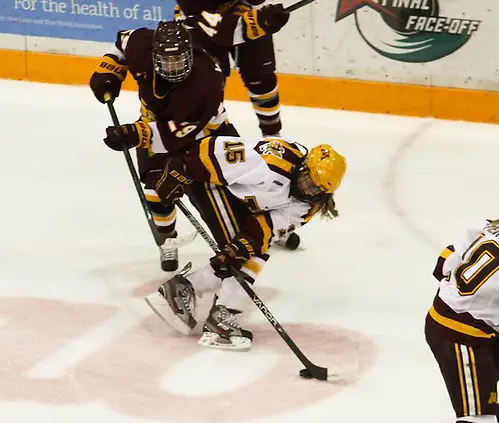


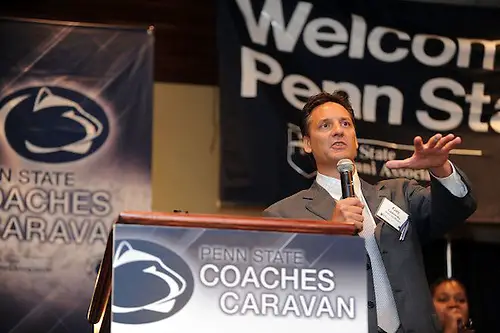
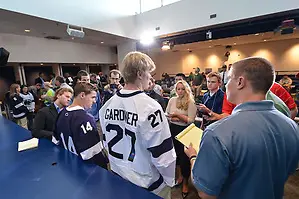
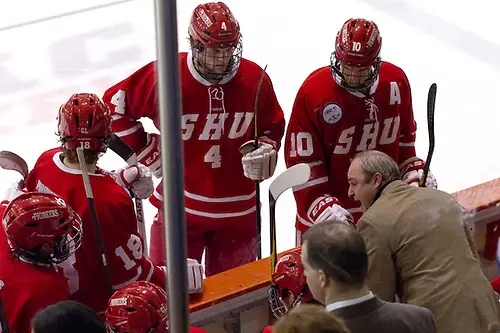
 <!–
<!–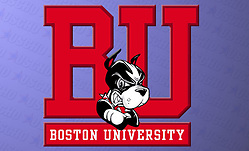 On top of the coaching change, BU fans really needed their game programs Friday night, as seven of the 18 skaters in a 3-1 win over Massachusetts were freshmen. Of course, the game marked the first time that Quinn had seen any of the current Terriers play in a game that counts.
On top of the coaching change, BU fans really needed their game programs Friday night, as seven of the 18 skaters in a 3-1 win over Massachusetts were freshmen. Of course, the game marked the first time that Quinn had seen any of the current Terriers play in a game that counts.